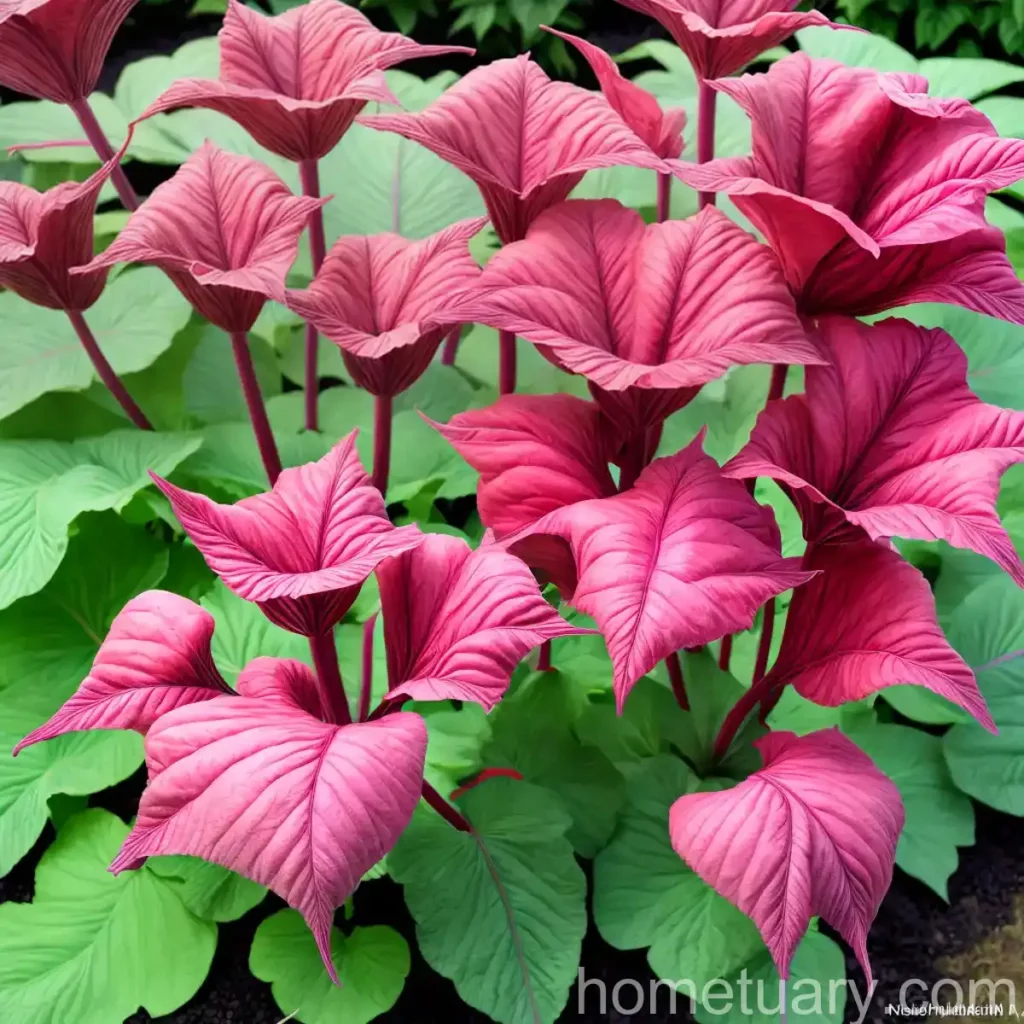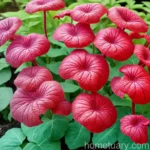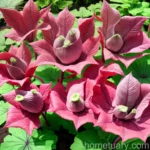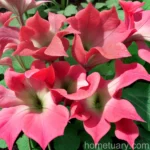The Allure of Rhubarb (Rheum x hybridum ‘K-1’ STARKRIMSON)
Introduction
Rhubarb, scientifically known as Rheum x hybridum ‘K-1’ STARKRIMSON, is a fascinating plant deeply rooted in history, culture, and practicality. Loved for its tart flavor, rhubarb is not just a culinary delight but also an ornamental addition to gardens. In this comprehensive guide, we will delve into the world of rhubarb, exploring its characteristics, growth requirements, popular uses, and much more. Let’s embark on an enlightening journey through the realm of rhubarb.
What is Rhubarb?
Rhubarb is a perennial plant that is cultivated for its edible and versatile stalks, which are used in a myriad of culinary applications ranging from pies and jams to savory dishes. Although it is commonly prepared as a fruit, rhubarb is botanically a vegetable. It is a member of the Polygonaceae family, closely related to sorrel and buckwheat. Rheum x hybridum, often known by the cultivar name ‘STARKRIMSON’, is a popular variety appreciated for its vibrant red stalks and exceptional productivity.
Plant Name: Rhubarb (Rheum x hybridum ‘K-1’ STARKRIMSON)
- Rhubarb Varieties: There are various rhubarb varieties available, each differing in characteristics such as taste, color, and size. The ‘STARKRIMSON’ cultivar is coveted for its striking red stalks and superior growth.
Key Takeaways
Before delving into the specifics of rhubarb cultivation and care, let’s highlight some key takeaways about the magnificent plant.
Rhubarb (Rheum x hybridum ‘K-1’ STARKRIMSON):
- Is a perennial, herbaceous plant with thick, edible stalks
- Thrives in cool climates and requires ample sunlight
- Can be propagated through division or from seeds
- Benefits from regular fertilization and well-draining soil
- Is susceptible to certain diseases and pests, necessitating proactive management and care
Now, let’s explore the various aspects of rhubarb cultivation and how to ensure the optimal growth and health of these distinctive plants.
Culture
Cultivating rhubarb is an endeavor that requires careful attention to specific cultural practices. Creating an environment conducive to rhubarb growth involves considerations such as water, sunlight, soil, and fertilization.
Water
Rhubarb plants have moderate water needs, and it is essential to maintain consistent soil moisture throughout the growing season, especially during dry periods. Overly moist conditions can lead to root rot, while excessively arid soil can hinder growth and reduce the quality of the stalks.
Sunlight
Sufficient sunlight is crucial for the development of healthy rhubarb plants. A minimum of 6 to 8 hours of direct sunlight per day is recommended to ensure robust growth and ample production of succulent stalks. In regions with scorching summers, partial shade during the hottest part of the day can protect the plants from excess heat.
Fertilizer
To support the vigorous growth of rhubarb, it is vital to provide proper nutrition in the form of fertilization. Before planting, enrich the soil with well-rotted compost or manure to enhance its fertility. During the growing season, a balanced fertilizer with a higher potassium content can be applied around the base of the plants to bolster their resilience and productivity.
Soil
Rhubarb flourishes in well-drained, fertile soil with a slightly acidic to neutral pH level. Loamy soil with a good organic matter content is ideal for cultivating rhubarb. Additionally, the soil should be free from any compacted layers to allow the roots to penetrate deeply and promote overall plant health.
Pruning
Pruning helps maintain the vitality and productivity of rhubarb plants, ensuring that they continue to yield bountiful harvests of delectable stalks.
Propagation
Rhubarb can be propagated through division or from seeds. Dividing mature rhubarb crowns is the preferred method for ensuring that the new plants retain the desired characteristics and qualities of the parent plant. Seed propagation, while possible, is less common due to the variability in traits exhibited by the resulting seedlings.
Container Popularity
While rhubarb is traditionally grown in garden beds, it is also well-suited for cultivation in containers. The portable nature of containers allows for greater flexibility in managing the growing environment and makes it possible for individuals with limited outdoor space to enjoy homegrown rhubarb.
Container
When selecting a container for growing rhubarb, opt for a large, sturdy pot with a depth of at least 24 inches to accommodate the robust root system of the plant. Ensure that the container has drainage holes to prevent waterlogging and root rot. Use a high-quality potting mix that offers excellent aeration and moisture retention to promote healthy growth.
Common Diseases
Rhubarb is susceptible to certain diseases, and being able to identify and manage these conditions is paramount in preserving the well-being of the plants.
Disease Diagnosis
- Crown Rot: This fungal disease, caused by various species of Phytophthora, manifests as rotting at the base of the plant and can result in wilting and eventual death if left unchecked. Proper drainage and soil management are crucial for preventing crown rot.
- Leaf Spot: Leaf spot diseases, such as Ramularia rhei, are characterized by the development of small, round lesions on the leaves, often surrounded by a halo. To combat leaf spot, promptly remove and dispose of affected foliage and ensure good air circulation around the plants.
- Bacterial Leaf Spot: This disease, caused by Xanthomonas campestris, leads to the appearance of dark, water-soaked spots on the leaves, potentially causing defoliation and weakening the plant. Copper-based fungicides can be used to manage bacterial leaf spot.
Common Pests
Various pests can pose a threat to the health and productivity of rhubarb plants, necessitating vigilance and proactive intervention to mitigate their impact.
Pest Identification
- Aphids: These small, sap-sucking insects congregate on the undersides of leaves, causing stunted growth and distortion of the foliage. Insecticidal soaps or neem oil can effectively control aphid infestations.
- Rhubarb Curculio: Rhubarb curculio adults feed on the edges of rhubarb leaves, resulting in characteristic notching along the leaf margins. Timely removal of affected leaves and the application of horticultural oil can help manage rhubarb curculio populations.
Botanist’s Tips
To ensure the successful growth and maintenance of rhubarb, consider the following expert recommendations:
– Select a planting site that receives ample sunlight and provides well-drained, fertile soil.
– Avoid planting rhubarb in areas prone to waterlogging, as excessive moisture can lead to root rot and other detrimental conditions.
– Provide regular, deep watering to sustain optimal soil moisture levels and aid in the development of succulent stalks.
– Mulch around rhubarb plants to suppress weeds, conserve soil moisture, and insulate the root zone against temperature fluctuations.
– Routinely inspect rhubarb plants for signs of diseases and pests, promptly addressing any issues to prevent their spread and escalation.
Fun Facts
Uncover the intriguing and delightful aspects of rhubarb with these captivating fun facts:
– Rhubarb is native to Siberia and has been cultivated for culinary and medicinal purposes for over 4,000 years.
– The stalks of rhubarb are the edible portion of the plant, while the large, heart-shaped leaves are toxic due to their high concentration of oxalic acid.
– Rhubarb was initially grown for its medicinal properties, serving as a remedy for ailments such as digestive issues and fever, before it gained popularity as a culinary ingredient.
Links to External Resources
For further information on rhubarb cultivation, maintenance, and usage, explore the resources provided below:
1. Rhubarb – University of Maryland Extension
2. Growing Rhubarb in the Home Garden – University of Minnesota Extension
3. Rhubarb: A Popular Perennial Vegetable – University of Illinois Extension
4. Rhubarb – Ontario Ministry of Agriculture, Food and Rural Affairs
5. Rhubarb Production in California – University of California Agriculture and Natural Resources
In conclusion, the cultivation and utilization of rhubarb offer a captivating blend of culinary, horticultural, and historical intrigue. By appreciating the unique characteristics of rhubarb and employing best practices in its care, enthusiasts can savor the delectable rewards of growing this remarkable plant. Whether relishing the tangy flavor of rhubarb in pies and preserves or admiring its striking foliage in the garden, rhubarb continues to captivate and inspire through its enduring allure.
References
- C.F. Hirsch, “Rhubarb: A Popular Perennial Vegetable”, University of Illinois Extension, https://web.extension.illinois.edu/herbs/rhubarb.cfm
- E. Nelson, “Growing Rhubarb in the Home Garden”, University of Minnesota Extension, https://extension.umn.edu/vegetables/growing-rhubarb-home-garden
- Ontario Ministry of Agriculture, Food and Rural Affairs, “Rhubarb”, Ontario Ministry of Agriculture, Food and Rural Affairs, http://www.omafra.gov.on.ca/english/crops/facts/89-018.htm
- University of California Agriculture and Natural Resources, “Rhubarb Production in California”, University of California Agriculture and Natural Resources, https://ucanr.edu/sites/Postharvest_Technology_Center_/files/293932.pdf
- University of Maryland Extension, “Rhubarb”, University of Maryland Extension, https://extension.umd.edu/hgic/topics/rhubarb















